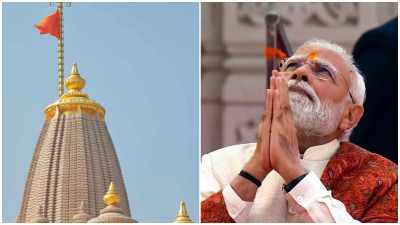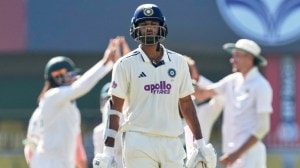The de-Vajpayeeisation of BJP
The TV camera has a way of capturing what a thousand words cannot. Last week there was the image of Atal Bihari Vajpayee coming out of Mumba...

The TV camera has a way of capturing what a thousand words cannot. Last week there was the image of Atal Bihari Vajpayee coming out of Mumbai’s Shanmukhananda Hall, after his ‘‘I have had enough’’ outburst. He stood all alone with just his SPG men behind him. He looked left, then right, and slowly moved forward. There was no BJP leader, not one, around the man who had steered a BJP-led government three times, who has 50 years of public life to his credit, who was being hailed by the party as its icon and its main message till a few weeks back, and whose photographs, 55 of them, filled the BJP’s Vision Document.
Few could feel happy about the humiliation heaped upon Vajpayee at the BJP’s Mumbai meet. It was truly a ‘‘bauchar’’ (shower) of barbs, provoking him to say, ‘‘For the first time I am under attack’’. Of course, this was not the first time an attempt had been made to sideline him.
In 1984, his JP-influenced ‘‘Gandhian Socialism’’ was replaced by the more hardline ‘‘Integral Humanism’’, after the party got only 2 seats in Lok Sabha under his stewardship. During the 1990 Rath Yatra, he was nowhere in the picture having made his opposition to it obvious. The two occasions when he asserted himself as prime minister were during the Lauh Purush-Vikas Purush controversy and when the sangh stepped up the campaign against Brajesh Mishra and Vajpayee fought back by threatening to quit.
We have known of de-Stalinisation in communist Russia. But one wishes such things did not happen in democratic India, though we saw Indira Gandhi deserted by supporters after her defeat in 1977 and P.V. Narasimha Rao isolated in 1996 when Sitaram Kesri took over as party president.
The de-Vajpayeeisation of the BJP shows the extent to which party leaders are at sixes and sevens after defeat. It is clear that an assertive RSS has come to the fore, now that the compulsions of power are no longer there. That is not surprising. What is curious is that the leadership of the BJP was not able to engage with the sangh leadership in quite the same way as it used to. For the last fifteen years, L.K. Advani has influenced the sangh as much as he has been influenced by it. Advani, who said only the other day that the BJP was a mass-based and not a cadre-based party, and that no ideological party could rule a vast country like India, and that ideology had to be delinked from governance, is saying exactly the opposite today.
It was equally painful to see Vajpayee do the flip-flops for which he has become legion. Even if he could not have his way on Modi at Mumbai, he need not have dismissed it as a ‘‘thing of the past’’ two days later. After an anguished ‘‘I have had enough’’, why say it was a joke and trivialise it? He could have just kept quiet. After all, even Jyoti Basu had to bow before the wishes of his party’s apex committee on the issue of PMship.
Individuals can do flip-flops and get away with it, though it affects their credibility. But it is that much more difficult for parties to do it without paying a price. Only six months ago, the BJP had shouted from rooftops that bijli-sadak-paani were its issues and it won resoundingly in Rajasthan, Madhya Pradesh and Chhattisgarh. Now it is saying those issues are not good enough and need to be backed by hindutva. The truth is that the BJP lost because it acquired a pro-rich image, as Vajpayee has said, allowed its allies to walk away and suffered from anti-incumbency. It has admitted that 50 per cent of its sitting candidates lost. But it is not as if the BJP is back to 2 seats; it is only seven seats behind the Congress. It lost 1.6 per cent of its voteshare in 2004. But so did the Congress, whose voteshare also dropped ironically by 1.6 per cent. The party won 145 seats because it forged winning alliances.
Now the BJP faces elections in half a dozen states like Maharashtra, Bihar, Jharkhand, Kerala. Its newly aggressive hindutva line may gel with Shiv Sena but what about Bihar and Jharkhand where it would need the JD(U)? It may bank on George Fernandes, but leaders like Sharad Yadav have already made public their unease with the BJP’s altered direction. Even if the party assumes that with the loss of power, which was the glue that bound the NDA, its allies, barring the Shiv Sena and the Akali Dal, may anyway distance themselves from it, irrespective of the line it decides to pursue, there is the future to consider in a coalition era.
In a parliamentary democracy, parties win and parties lose. From the treasury benches, the defeated party moves to the opposition benches. It bides its time, waits for the government to make mistakes, which all governments do, mounts an attack and bounces back. Defeat does not lead to the collapse of the inner fabric of the party, or plunge it into an identity crisis, as seems to be happening with the BJP. That is unfortunate. You may agree or disagree with the BJP’s politics, but a vigorous and vigilant opposition is the sine qua non of a healthy democracy.



- 01
- 02
- 03
- 04
- 05




























